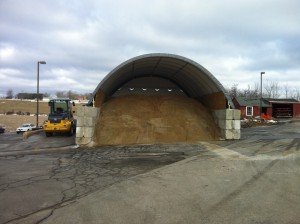Although signs of spring are appearing around us (crocuses are up at my house!), the remnants of winter linger. Piles of dirty snow snow still litter the landscape, refusing to yield to the lengthening days. Very soon our thoughts and activities will turn to all things spring; snowplows and road salt will be distant memories. Unfortunately for many of our streams and the aquatic life in them, the effects of our winter activities linger year round.

Application of road salt for winter deicing has been standard practice since the 1940s. Maintenance of safe roadways for transportation has been of great concern to state departments of transportation, local municipalities, and public and private institutions (UConn is no exception-see photo). In Connecticut, road salt was typically mixed with sand for application to roads. Sand had its own set of problems-it needed to be cleaned out of catch basins and swept off the roads in the spring, and it had the potential to fill in stream habitat. Around 2006, CT DOT switched to pretreatment of highways with brine, and eliminated the use of sand. The justification was that decreasing the use of sand was a benefit to waterways, and use of road salt (sodium chloride) and calcium or magnesium chloride would be more effective in clearing snow and ice from our roads. Many municipalities and institutions have followed suit (if you have visited any large parking lot this winter you may have noticed the white coating of salt left after a storm). DOT saves money with this approach (spring cleanup costs are greatly reduced), but the salts are leading to increased concern about corrosion of vehicle systems. If you are a mayfly larva or a native brook trout, you may not care about corrosion on vehicles, but you would care about increasing levels of chloride in local streams.
When salts dissolve in water, they dissociate. For example, sodium chloride (NaCl) dissociates into a positively charged sodium cation (Na+), and a negatively charged chloride ion (Cl-). The problem with chloride is that because it is negatively charged, it is not retained well by soils (which also have negatively charged surfaces), so it moves freely off roads, through the soil, and into the shallow groundwater, where it then travels to our streams. As early as 1988, the US EPA had recognized that chloride from road salting was causing problems in waterways. A chronic exposure criterion for aquatic life was found to be 230 mg/L for chloride. What this means is that if a stream has chloride concentrations above this level for a long period of time, aquatic life is negatively impacted. The acute (short term) exposure criterion is 1,720 mg/L. Chloride levels in streams have been rising steadily in the northeastern U.S. and in the midwest. Perhaps not surprisingly, groundwater and streams in urban areas of the Northeast seem to have the highest concentrations of chloride, with median concentrations right around the chronic criterion (see USGS study).
Eagleville Brook is a small stream that drains a good portion of the UConn campus in Storrs. As part of the Eagleville Brook TMDL project, discharge, temperature and specific conductance (see note on units below) are being measured continuously. As part of a Section 319 award from CT DEEP, Jack Clausen from the NRE department at UConn is taking weekly grab samples from the brook, and they are being analyzed for copper and chloride. Check out the real-time monitoring after a winter salting-you will see conductance values go from around 1 mS/cm (1,000 µS/cm) in baseflow to as much as 20 mS/cm (20,000 µS/cm) after a storm! Chloride concentrations in grab samples have followed similar trends, with median concentrations around 400 mg/L and peaks after a winter storm of nearly 5,000 mg/L (remember the acute and chronic criteria above?). So even on a good day in Eagleville Brook, it is not a pleasant place if you are an aquatic organism, and after a winter salting event, it could be downright deadly.
Typical stormwater treatment practices do not help this problem. Unfortunately, although the Low Impact Development practices that are being implemented regularly on campus remove many other pollutants, they do not trap chloride at all. Reducing the amount of salt applied is one management step that has been taken by some municipalities/institutions, but they also need to balance pedestrian and vehicle safety concerns.
Quoting from Kaushal, et al. (2004): “salinization associated with increasing suburban and urbanization deserves attention as one of the most significant threats to the integrity of freshwater ecosystems in the northeastern United States.” I am afraid I have to agree…this study is nearly 10 years old, and salt applications have only increased since then. I wish a had a more uplifting ending to this blog…unfortunately it seems that this problem will get worse before it gets better.
Note on units: Specific conductance measures the electrical conductivity of the water; it has been used as a substitute measurement for chloride, as it is easier to obtain. Conductance units (µS/cm) are roughly 5 times chloride concentrations in mg/L.